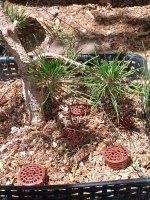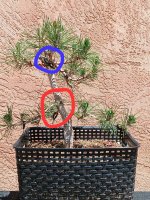NMbonsai
Yamadori
Hello fellow bonsai nuts. I have some questions regarding the next step in development on a Japanese Black pine.
I have had this nursery stock JBP "Kutobuki" for several years. It has been in a training basket with bonsai soil (A/P/L plus some organics) for two years, but I did not do any work on the upper parts. At the end of January this year (2025), I became concerned about the inverse taper starting to develop at the branch whorls, so I did a trunk chop just above the second whorl and reduced the branches to two at each whorl.
On April 1st, I wired the branches and used guy wires to pull some branches downwards. I started fertilizing the tree last year with Biogold and this January started feeding with a slow release granular fertilizer (17-6-12).
The tree has responded well to the pruning and fertilizing and is producing candles on all the remaining branches. My questions are:
1) Should I not decandle at all this season and just let the tree build strength and recover from the work done on it earlier this year? If so, will the resulting branches grow too long and have to be cut back next year?
2) If I do decandle in about a month (early to mid June), should I remove candles over the whole tree or just from the top (future apex) branches? As shown in the last two pictures, the new growth appears to be pretty equal at both the top and bottom of the tree. It has one back branch near the bottom of the tree that has one very tiny bud near the tip, so I will definitely leave that one alone.
The tree is now about 15 inches tall and I don't really want it to get any taller, just more ramified. As I see it, it has two major design flaws. One is the inverse taper below the graft union with no root flare. The other is the straight section between the top branches and the next lower branch. I hope that these will become less noticeable as the tree ages and fills out.
.



I have had this nursery stock JBP "Kutobuki" for several years. It has been in a training basket with bonsai soil (A/P/L plus some organics) for two years, but I did not do any work on the upper parts. At the end of January this year (2025), I became concerned about the inverse taper starting to develop at the branch whorls, so I did a trunk chop just above the second whorl and reduced the branches to two at each whorl.
On April 1st, I wired the branches and used guy wires to pull some branches downwards. I started fertilizing the tree last year with Biogold and this January started feeding with a slow release granular fertilizer (17-6-12).
The tree has responded well to the pruning and fertilizing and is producing candles on all the remaining branches. My questions are:
1) Should I not decandle at all this season and just let the tree build strength and recover from the work done on it earlier this year? If so, will the resulting branches grow too long and have to be cut back next year?
2) If I do decandle in about a month (early to mid June), should I remove candles over the whole tree or just from the top (future apex) branches? As shown in the last two pictures, the new growth appears to be pretty equal at both the top and bottom of the tree. It has one back branch near the bottom of the tree that has one very tiny bud near the tip, so I will definitely leave that one alone.
The tree is now about 15 inches tall and I don't really want it to get any taller, just more ramified. As I see it, it has two major design flaws. One is the inverse taper below the graft union with no root flare. The other is the straight section between the top branches and the next lower branch. I hope that these will become less noticeable as the tree ages and fills out.
.





